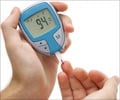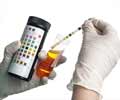Massachusetts-based Draper Laboratories is trying to develop a special tattoo ink that changes colour based on glucose levels inside the skin.
Massachusetts-based Draper Laboratories is trying to develop a special tattoo ink that changes colour based on glucose levels inside the skin.
Nanotechnology researchers associated with the project believe that the injectable ink may one day prove helpful in freeing diabetics from painful blood glucose tests."It doesn't have to be a large, over-the-shoulder kind of tattoo. It would only have to be a few millimeters in size and wouldn't have to go as deep as a normal tattoo," Discovery News quoted Heather Clark, a scientist at Draper, as saying.
She has revealed that her team did not actually set out to create a glucose-detecting ink.
"At first I didn't even think it was possible," she said.
Heather revealed that she and her colleagues originally created a sodium-sensitive ink to monitor heart health, advancing basic knowledge of electrolytes in the body, or to ensure athletes are properly hydrated.
She said that it was only after talking to a colleague that she decided to give glucose detection a try, and started with the basic three-part system to detect sodium and modified to detect glucose.
Advertisement
Heather says that the particles look like food colouring when dissolved in water.
Advertisement
Upon approaching the surface, she says, the glucose detecting molecule either grabs a molecule of glucose or the mimicking molecule.
If the molecules mostly latch onto glucose, the ink appears yellow. If glucose levels are low, the molecule latches onto the glucose mimic, turning the ink purple. A healthy level of glucose has a "funny orangey," colour.
According to Heather, the sampling process repeats itself every few milliseconds.
She says that even if there is a significant lag time between blood and skin glucose levels, a small tattoo would let diabetics know if an abnormally high or low reading was either returning to a normal level or getting worse.
She has revealed that the testing of the glucose monitoring nanotech ink in mice could begin by the end of this month, and human testing may have to wait for at least two years.
Robert Rubin, a professor at Harvard Medical School, is excited by Clark's work at Draper.
"This will give me a great short cut for understanding what is happening inside the body," said Rubin.
Source-ANI
SRM















